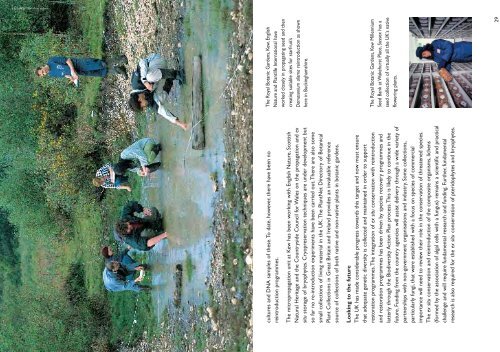Objective 2: Conserving <strong>Plant</strong> <strong>Diversity</strong>Target 8:Linking ex situ and in situconservationOngoing actions contributing tomeeting the target• Collecting and storing vascular plants,primarily in the Millennium Seed Bank, andreintroducing them as determined by theBiodiversity Action Plan process• Developing methodologies for the ex situconservation and reintroduction ofbryophytes• Developing the collections managed by theUK National Culture Collection networkHigh priority additional work• Developing an integrated inventory of‘living’ plant and fungal collections• Researching the storage of pteridophytespores• Developing scientific and horticulturalexpertise for the ex situ conservation ofvascular plants and reintroductions• Researching the ex situ conservation oflichens and their reintroductionMedium priority additional work• Developing conservation collections ofthreatened species of fungi and otherorganisms held as part of the UK NationalCulture Collection. Evaluating the need forand constraints of reintroduction andrestoration projects for these species• Developing protocols and guidelines forconservation programmes to release thepotential contribution from specialist plantsocieties, nurseries and gardenersLower priority or long-term additionalwork• Following the development of protocolsand baseline collections - developingcollections to ensure that adequate geneticdiversity of each species is maintained tosupport restoration programmes60 per cent of threatened plant species in accessibleex situ collections, preferably in the country of origin, and10 per cent of them included in recovery and restorationprogrammes.ScopeThis target seeks to underpin the conservation of threatened plant species throughthe maintenance of living collections, citing botanic gardens, seed banks and tissueculture collections as examples. Priority should be given to those threatened speciesin the IUCN Red Data Book category of ‘critically endangered’, with a target of 90%of such species in ex situ conservation. In the UK, focus should include species listedin the Habitats and Species Directive and the UK and European Red Data Books, inaddition to those that are ‘critically endangered’ at a global level.Current situationVascular plants are generally well represented in ex situ collections; for example, theMillennium Seed Bank at the Royal Botanic Gardens, Kew, holds seeds of around94% of the UK’s native seed-bearing plants.This project has been working withEnglish Nature to improve coverage of the Red Data Book/Biodiversity Action Planspecies, and out of the 131 species selected by English Nature, 110 are representedin the Bank and 40 have complete or adequate geographical coverage.The UKNational Culture Collection network comprises organisations holding living culturesof a range of organisms, including freshwater and marine algae and protozoa, woodrottingmacrofungi, yeast cultures and pathogenic fungi.Although threatened speciesare included within these collections, the emphasis is on those species ofcommercial significance.The Royal Botanic Garden Edinburgh has a spore bank for a number of threatenedpteridophytes, but more research is needed into the long-term storage of spores.They also maintain living collections of fern species. Reintroductions have beencarried out, for instance of oblong woodsia Woodsia ilvensis. Ex situ conservation oflichens suffers from a lack of professional lichenologists and an absence of basicresearch into conservation techniques. Fungal strains can be preserved cryogenically,but little work has been done on the ex situ propagation and cultivation of wholelichens or their reintroduction into the wild.There has been increasing interest inthe conservation of fungi in recent years, but there is a fundamental lack ofknowledge about some aspects of the mycota of the UK. Some groups have beenrelatively well studied, e.g. the Basidiomycetes, but others have been neglected orhave received patchy coverage.There are conservation collections of pathogenic andwood-rotting species held as part of the UK National Culture Collection, but thereis no emphasis on threatened species.The Mycology Section at Kew has done somework on threatened species in conjunction with English Nature, and holds both living28
SIMON WILLIAMS/PLANTLIFEcultures and DNA samples of these.To date, however, there have been noreintroduction programmes.The micropropagation unit at Kew has been working with English Nature, ScottishNatural Heritage and the Countryside Council for Wales on the propagation and exsitu storage of bryophytes. Cryopreservation techniques are under development butso far no re-introduction experiments have been carried out.There are also somesmall collections of living material in the UK.The <strong>Plant</strong>Net Directory of Botanical<strong>Plant</strong> Collections in Great Britain and Ireland provides an invaluable referencesource of collections of both native and non-native plants in botanic gardens.Looking to the futureThe UK has made considerable progress towards this target and now must ensurethat adequate genetic diversity is collected and maintained in order to supportrestoration programmes.The integration of ex situ conservation with reintroductionand restoration programmes has been driven by species recovery programmes andlatterly through the Biodiversity Action Plan process.This is likely to continue in thefuture. Funding from the country agencies will assist delivery through a wide variety ofpartnerships with non-government organisations and industry. Some collections,particularly fungi, that were established with a focus on species of commercialimportance will need to review their role in the conservation of threatened species.The ex situ conservation and reintroduction of the composite organisms, lichens(formed by the association of algal cells with a fungus) remains a scientific and practicalchallenge and will require fundamental research and funding. Further, fundamentalresearch is also required for the ex situ conservation of pteridophytes and bryophytes.The Royal Botanic Gardens, Kew, EnglishNature and <strong>Plant</strong>life International haveworked closely in propagating seed and thencreating suitable sites for starfruit’sDamasonium alisma reintroduction as shownhere in Buckinghamshire.The Royal Botanic Gardens, Kew MillenniumSeed Bank at Wakehurst Place, Sussex has aseed collection of virtually all the UK's nativeflowering plants.29
















